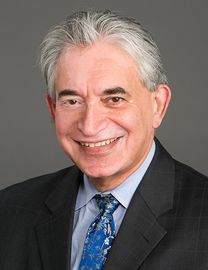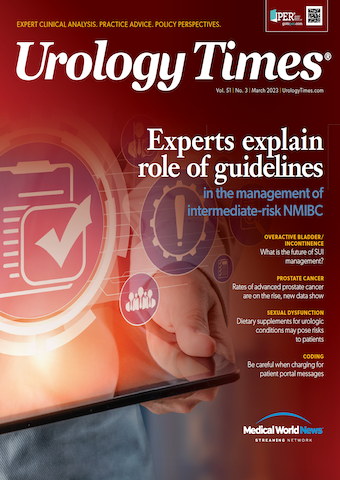Publication
Article
Urology Times Journal
What is the future of stress urinary incontinence management?
Author(s):
"Until a better option comes along, its low cost (mesh alone) and ease of use allows a standardized approach in an appropriately selected patient," writes Gopal H. Badlani, MD.
Gopal H. Badlani, MD

When asked about the future of stress urinary incontinence (SUI) management, it made me reflect on 4 decades of learning, treating patients, and striving to find the next best treatment approach. To paraphrase Herbert Spencer, we must remember we are all descendants of the past but parents of the future. Thus we will collectively determine the future.
Guidelines have helped us define the evidence-based approach. The 2017 American Urological Association/Society of Urodynamics, Female Pelvic Medicine & Urogenital Reconstruction guideline for SUI,1 in addition to broadening the index patient, highlights the separation of mixed incontinence, a more common clinical condition. Using the algorithmic approach works only by individualizing the variations each patient presents.
The host tissue–based approach shows a slow decline in efficacy, as demonstrated by results from a number of studies,2 including the robust randomized SISTEr trial (NCT00064662).3 Is this due to the technique, with more than 100 procedures having been described? Or is it more likely due to host factors where the breakdown of collagen and elastin is faster, caused by genetic influence; phenotypic causes of parity, age, and hormonal status; chronic cough and obesity.4,5
Despite long-term evidence–based efficacy of the midurethral sling, emotional response to product-related complication in 3% or less of patients has led to its ban in many countries, denying patients an effective cure.6 The compromise is to revert to bioinjectable treatment, which was almost abandoned with the advent of minimally invasive slings. The resurgence of Bulkamid not only for SUI but also mixed incontinence is expensive, and a careful review of results from the pivotal trial for FDA approval shows only marginal improvement over collagen. Bulkamid demonstrated noninferiority but not with the objective success of the midurethral sling.7
Thus, attention has come back to regenerative therapy. Once again, cell therapy, despite early success, has not been better than commercial injectable materials. This is perhaps due to 2 reasons. One is that the experimental basis for cell therapy was based on acute injury animal models, whereas human patients have chronic injury status. The second is that injected cells, when replaced by host cells, persist with inherent biochemical and genetic defects.8
Use of chemokine to attract bone marrow and mesenchymal cells to the injected site has had a better response than cell therapy.9 Other innovations include low-energy shock wave therapy10 or acoustic pulses11 to replicate injury response by the host at the site. Recent efforts include injecting host-derived muscle fibers to obviate the step of cell culture and hasten the formation of myotubes.12
We still have more questions than answers, including the following:
1. What proof of concept should be required to use novel procedures for patients?
2. How do we interpret results from experimental studies performed on healthy animals?
3. Is animal evidence adequate? Which is appropriate: dog, pig, or primate?
4. Which injury model should be used?
Lightweight, large-pore mesh use has improved outcomes in SUI surgery and decreased morbidity. However, it is associated with a rate of functional and/or product-related complications. Until a better option comes along, its low cost (mesh alone) and ease of use allows a standardized approach in an appropriately selected patient.
References
1. Kobashi KC, Albo ME, Dmochowski RR, et al. Surgical treatment of female stress urinary incontinence: AUA/SUFU guideline. J Urol. 2017;198(4):875-883. doi:10.1016/j.juro.2017.06.061
2. Saraswat S, Rehman H, Omar MI, et al. Traditional suburethral sling operations for urinary incontinence in women. Cochrane Database Syst Rev. 2020;2020(1):CD001754. doi:10.1002/14651858.CD001754.pub5
3. Richter HE, Brubaker L, Stoddard AM, et al. Patient related factors associated with long-term urinary continence after Burch colposuspension and pubovaginal fascial sling surgeries. J Urol. 2012;188(2):485-489. doi:10.1016/j.juro.2012.04.010
4. Patel PD, Amrute KV, Badlani GH. Pelvic organ prolapse and stress urinary incontinence: a review of etiological factors. Indian J Urol. 2007;23(2):135-141. doi:10.4103/0970-1591.32064
5. McKenzie P, Rohozinski J, Badlani G. Genetic influences on stress urinary incontinence. Curr Opin Urol. 2010;20(4):291-295. doi:10.1097/MOU.0b013e32833a4436
6. Riccetto CLZ. Synthetic slings in the treatment of urinary incontinence: lessons learned and future perspectives. Int Braz J Urol. 2020;46(4):651-654. doi:10.1590/S1677-5538.IBJU.2020.04.04
7. Badlani G. Re: seven-year efficacy and safety outcomes of Bulkamid for the treatment of stress urinary incontinence. Eur Urol. Published online January 12, 2023. doi:10.1016/j.eururo.2022.12.032
8. Williams JK, Dean A, Lankford S, et al. Determinates of muscle precursor cell therapy efficacy in a nonhuman primate model of intrinsic urinary sphincter deficiency. Stem Cell Res Ther. 2017;8:1. doi:10.1186/s13287-016-0461-6
9. Williams JK, Dean A, Badra S, et al. Cell versus chemokine therapy in a nonhuman primate model of chronic intrinsic urinary sphincter deficiency. J Urol. 2016;196(6):1809-1815. doi:10.1016/j.juro.2016.05.106
10. Wang B, Zhou J, Banie L, et al. Low-intensity extracorporeal shock wave therapy promotes myogenesis through PERK/ATF4 pathway. Neurourol Urodyn. 2018;37(2):699-707. doi:10.1002/nau.23380
11. Cui K, Kang N, Banie L, et al. Microenergy acoustic pulses induced myogenesis of urethral striated muscle stem/progenitor cells. Transl Androl Urol. 2019;8(5):489-500. doi:10.21037/tau.2019.08.18
12. Ko IK, Yoo ES, Park SM, et al. Use of uniformly sized muscle fiber fragments for restoration of muscle tissue function. J Tissue Eng Regen Med. 2019;13(7):1230-1240. doi:10.1002/term.2873






























